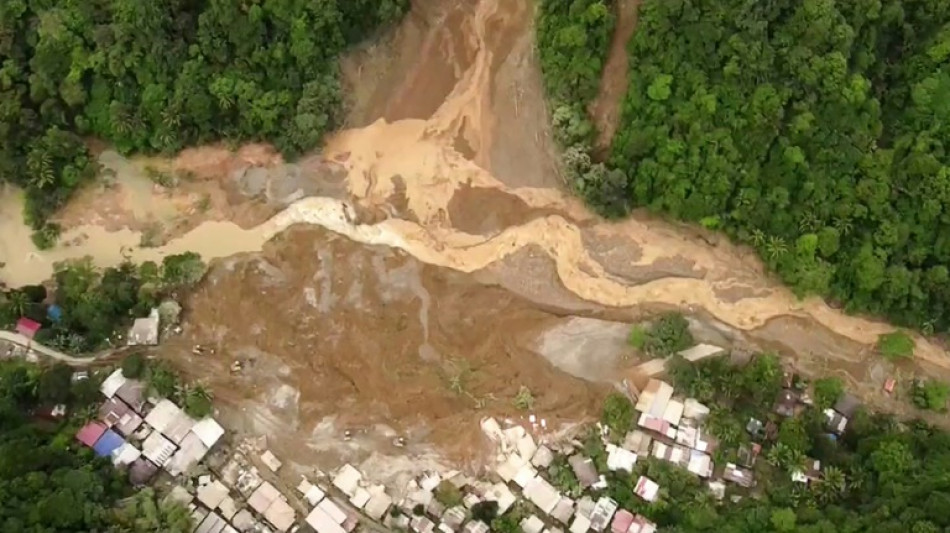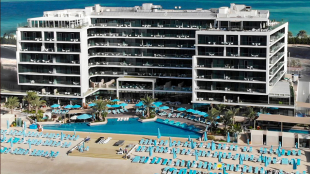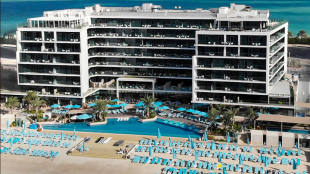
-
 Biden begins historic Amazon trip amid Trump climate fears
Biden begins historic Amazon trip amid Trump climate fears
-
Dozens killed, missing in Israeli strike on devastated north Gaza

-
 Macron defends French farmers in talks with Argentina's Milei
Macron defends French farmers in talks with Argentina's Milei
-
England players to blame for losing streak says captain George

-
 'Emotional' Martin defies Bagnaia to claim first MotoGP world championship
'Emotional' Martin defies Bagnaia to claim first MotoGP world championship
-
Slovakia beat Australia to reach BJK Cup semi-finals

-
 Sluggish Italy fight to narrow win over Georgia
Sluggish Italy fight to narrow win over Georgia
-
India and Nigeria renew ties as Modi visits

-
 Grit and talent, a promise and a dilemma: three things about Jorge Martin
Grit and talent, a promise and a dilemma: three things about Jorge Martin
-
Martin denies Bagnaia to win first MotoGP world championship

-
 Typhoon Man-yi weakens as it crosses Philippines' main island
Typhoon Man-yi weakens as it crosses Philippines' main island
-
Noel wins season-opening slalom in Levi as Hirscher struggles

-
 Tough questions for England as Springboks make it five defeats in a row
Tough questions for England as Springboks make it five defeats in a row
-
Russia pounds Ukraine with 'massive' attack in 'hellish' night

-
 McIlroy clinches Race to Dubai title with DP World Tour Championship win
McIlroy clinches Race to Dubai title with DP World Tour Championship win
-
Glastonbury 2025 tickets sell out in 35 minutes

-
 迪拜棕榈岛索菲特美憬阁酒店: 五星級健康綠洲
迪拜棕榈岛索菲特美憬阁酒店: 五星級健康綠洲
-
The Retreat Palm Dubai MGallery by Sofitel: Пятизвездочный велнес-оазис

-
 New Zealand win revives France on their road to 2027 World Cup
New Zealand win revives France on their road to 2027 World Cup
-
The Retreat Palm Dubai MGallery by Sofitel: A five-star wellness Oasis

-
 Israel hits Gaza and Lebanon in deadly strikes
Israel hits Gaza and Lebanon in deadly strikes
-
Power cuts as Russian missiles pound Ukraine's energy grid

-
 Denmark's Victoria Kjaer Theilvig crowned Miss Universe 2024
Denmark's Victoria Kjaer Theilvig crowned Miss Universe 2024
-
Dutch police use hologram to try and decode sex worker's murder

-
 Israel bombs south Beirut after Hezbollah targets Haifa area
Israel bombs south Beirut after Hezbollah targets Haifa area
-
Biden in historic Amazon trip as Trump return sparks climate fears

-
 India hails 'historic' hypersonic missile test flight
India hails 'historic' hypersonic missile test flight
-
Israel orders Beirut residents to flee after Hezbollah targets Haifa area

-
 Davis, LeBron power Lakers over Pelicans as Celtics win in OT
Davis, LeBron power Lakers over Pelicans as Celtics win in OT
-
Trump and allies return to New York for UFC fights

-
 Hong Kong political freedoms in spotlight during bumper trial week
Hong Kong political freedoms in spotlight during bumper trial week
-
Debt-saddled Laos struggles to tame rampant inflation

-
 Senna, Schumacher... Beganovic? Macau GP showcases future F1 stars
Senna, Schumacher... Beganovic? Macau GP showcases future F1 stars
-
India's vinyl revival finds its groove

-
 G20 tests Brazil's clout in Lula 3.0 era
G20 tests Brazil's clout in Lula 3.0 era
-
Over 20,000 displaced by gang violence in Haiti: UN agency

-
 Famed gymastics coach Bela Karolyi dies
Famed gymastics coach Bela Karolyi dies
-
'Break taboos': Josep Borrell wraps up time as EU's top diplomat

-
 Climate finance can be hard sell, says aide to banks and PMs
Climate finance can be hard sell, says aide to banks and PMs
-
Trump revives 'peace through strength,' but meaning up to debate

-
 New York auction records expected for a Magritte... and a banana
New York auction records expected for a Magritte... and a banana
-
Egypt's middle class cuts costs as IMF-backed reforms take hold

-
 Beirut businesses struggle to stay afloat under Israeli raids
Beirut businesses struggle to stay afloat under Israeli raids
-
Dupont lauds France 'pragmatism' in tight New Zealand win

-
 Swiatek leads Poland into maiden BJK Cup semi-final
Swiatek leads Poland into maiden BJK Cup semi-final
-
Trump taps fracking magnate and climate skeptic as energy chief

-
 West Indies restore pride with high-scoring win over England
West Indies restore pride with high-scoring win over England
-
Hull clings to one-shot lead over Korda, Zhang at LPGA Annika

-
 Xi tells Biden ready for 'smooth transition' to Trump
Xi tells Biden ready for 'smooth transition' to Trump
-
Trump nominates fracking magnate and climate skeptic as energy secretary


Landslide at Philippine gold-mining village kills seven
At least seven people were killed and 31 injured when a rain-induced landslide hit a gold-mining village in a mountainous region of the southern Philippines, officials said Wednesday.
The landslide Tuesday night struck Masara in Davao de Oro province on Mindanao island, provincial disaster official Edward Macapili told AFP, destroying houses and engulfing three buses and a jeepney waiting for mine workers.
Rescuers were digging through mud to find 48 people reported missing, including at least 20 people trapped inside the vehicles, officials said.
At least 28 people were on board the vehicles when the landslide hit, but eight managed to escape unhurt through the windows before the mud engulfed them, Macapili said.
The buses and jeepney had been outside a gold mine operated by the Philippine company Apex Mining where they drop off and pick up workers.
Initial reports said two buses were hit by the landslide, but Apex Mining said in a statement Wednesday afternoon that three 60-seater buses and a 36-person-capacity jeepney were impacted.
A fourth bus had left before the mud swamped the area, the firm said, adding that 62 employees were safe while 45 were missing.
Landslides are frequent hazards across much of the archipelago nation owing to the mountainous terrain, heavy rainfall and widespread deforestation from mining, slash-and-burn farming and illegal logging.
Science and Technology Secretary Renato Solidum said a number of huge earthquakes had destabilised the region in recent months.
"Every time there's a major earthquake we have to worry about multiple landslides every time the rains come," Solidum told a disaster briefing attended by President Ferdinand Marcos.
Aerial video showed a deep, brown gouge down the side of a forested mountain that reaches the village below where a number of houses had been destroyed.
Land above the landslide appears to have been cleared for crops.
Rescue teams from across the region have been deployed to help search the large area under mud, Macapili said.
"We have equipment but we're mostly doing it manually because digging with backhoes is dangerous as you don't know if there are people trapped beneath the debris," he said.
Seven bodies have been pulled out so far, an official from the Maco municipal disaster agency said.
Among the 31 villagers injured in the landslide, two were seriously hurt and were airlifted to a hospital in Davao city for treatment, Macapili said.
"There was no sign that a landslide would occur because the rains stopped on Thursday and by Friday it was already sunny and hot," he added.
- Forced evacuations -
The official said an earthquake shook the village shortly after the landslide. The search effort was halted at midnight because it was too hazardous to continue, but resumed at daylight, he said.
In a statement to the Philippine Stock Exchange, Apex Mining said it had reduced operations as it assists the rescue effort with equipment, personnel and food.
Meanwhile, hundreds of families from Masara and four nearby villages have been forced to evacuate from their homes and shelter in emergency centres.
Rain has pounded parts of Mindanao off and on for weeks, forcing tens of thousands into shelters.
At least 18 people died from landslides and flooding in the region last week, the national disaster agency said in its latest update, as the northeast monsoon and a low pressure trough brought downpours.
A powerful magnitude 7.6 earthquake struck off the east coast of Mindanao in December, briefly triggering a tsunami warning, and was followed by a series of major aftershocks.
Earthquakes regularly strike the Philippines, which sits along the Pacific Ring of Fire, an arc of intense seismic and volcanic activity that stretches from Japan through Southeast Asia and across the Pacific basin.
H.Thompson--AT
